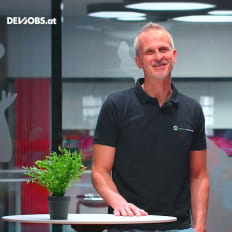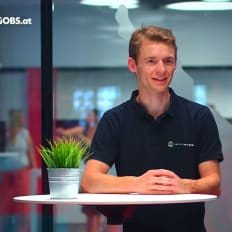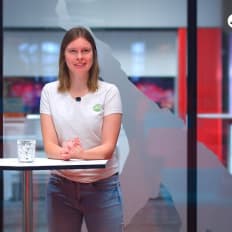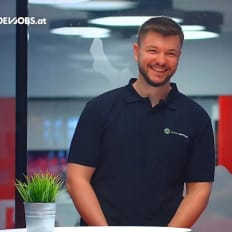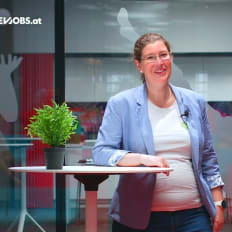
solvistas GmbH
Markus Hiesmair, Software Engineer bei solvistas
Description
Markus Hiesmair von solvistas erzählt im Interview über seinen Werdegang als Software Engineer – angefangen von der Schulzeit bis hin zur aktuellen Arbeit – und gibt Tipps für Neueinsteiger.
By playing the video, you agree to data transfer to YouTube and acknowledge the privacy policy.
Video Summary
In “Markus Hiesmair, Software Engineer bei solvistas,” Markus Hiesmair traces his path from HTL Leonin through a GWT internship and an informal post-military-service application to solvistas, working part-time during university before moving to full-time and valuing the practical learning on the job. He now serves as Technical Lead for a ticketing product for sports clubs and event organizers (e.g., Black Wings, Blau-Weiß Linz), doing full-stack Spring/Angular development in the cloud and coaching his team. His advice: start with curiosity and experimentation, leverage formal education but prioritize project experience; as a tech lead, communicate goals clearly, collaborate well, and justify decisions with solid experience.
From HTL Internship to Technical Lead: The DevStory of Markus Hiesmair (solvistas GmbH)
A beginning without a master plan—and an early love for programming
In our DevJobs.at devstory “Markus Hiesmair, Software Engineer bei solvistas” (solvistas GmbH), we meet a developer journey that feels familiar to many engineers: you enter the field without fully knowing what to expect, and along the way you discover a genuine passion for it.
Markus puts his start plainly:
“Ja, ich habe angefangen in der HTL Leonin … eigentlich habe ich noch nicht recht gewusst, was mich erwartet … bin dann aber recht schnell auf den Geschmack gekommen, also mir hat das ganze Programmieren einfach getaugt.”
That simple, honest beginning frames a pattern we see throughout his path: curiosity, trying things, sticking with it. He doesn’t pit school against practice, but he draws a clear line between them. After graduating from school (Matura), he chose to study—and he knew practical experience would matter just as much.
The first bridge to practice: an internship with substance
The bridge into professional life came early. Markus “landed” at solvistas via an internship during his HTL years. The assignment was specific: one month evaluating GWT.
“Bei der Solvistas bin ich gelandet, eigentlich durch ein Praktikum … habe einen Monat GWT, war das damals, evaluiert.”
There’s a lot inside that short passage for aspiring developers:
- An internship can be more than “helping out”—it can have a clearly scoped technical goal.
- To evaluate means to form hypotheses, test, compare, and conclude—this thinking later powers projects.
- A month of focused tech deep dive can open doors—if you deliver results and make your learning visible.
That internship wasn’t a one-off. It became the foundation for his later entry—without rigid application rituals.
The “informal” entry, military service, and the study–work double act
Following his military service (Bundesheer), Markus chose a direct route:
“Nach dem Bundesheer habe ich mich dann einfach nochmal ganz informell beworben und habe dann noch gearbeitet und dann zum Studieren angefangen und Teilzeit weitergearbeitet … bis zum Ende vom Studium und dann bin ich auf Vollzeit umgestiegen.”
It’s a blend of pragmatism and consistency: knock on the door informally, get to work, start studying, keep working part-time, and later switch to full-time. He draws a crystal-clear comparison between theory and practice:
“Neben dem Studium, Arbeit ist etwas ganz anderes … man lernt ganz andere Sachen und es ist viel praxisnahe.”
For early-career engineers, that’s a valuable reality check. University and work don’t cancel each other out—they reinforce each other. Theory gives you concepts and vocabulary; practice provides context, trade-offs, and feedback. Combine both, and you’ll grow faster—technically and personally.
Product focus: ticketing for sports clubs and event organizers
At solvistas, Markus works in a clearly defined domain:
“Wir machen … Software für Sportvereine, also eigentlich für Event-Veranstalter, eine ganz normale Ticketing-Lösung, zum Beispiel Black Wings oder Blau-Weiß Linz … wir machen die Ticketing-Software für die, also wir haben da ein Produkt …”
This product focus shows how real-world use cases shape technical choices. Ticketing is a domain where reliability, performance, and operations matter deeply—think sales peaks or last-minute changes. Markus states the responsibility without drama, but with precision: it’s about the product, about operations, and about continued development.
Role and responsibility: Technical Lead with an eye on operations and evolution
Markus describes his role in the project this way:
“Ich bin da in dem Projekt Technical Leads, das heißt, ihr habt Verantwortung mehr oder weniger für alles, was technisch ist und für den Betrieb von der Software, von dem Produkt und halt auch für alle Weiterentwicklung.”
That maps to a set of tasks that clearly go beyond writing code:
- Define and communicate technical direction.
- Make decisions and justify them.
- Think in terms of operational reliability—and deliver it.
- Align product requirements with the development roadmap.
- Coach and enable the team.
It’s a demanding blend—and emblematic of many Technical Lead roles in product-driven environments.
Full-stack with Spring and Angular—running in the cloud
On the tech foundation, Markus is succinct and specific:
“Was ich mache, ist natürlich Full-Stack-Entwicklung, wir sind Spring Angular hauptsächlich und es läuft alles in der Cloud …”
Spring and Angular anchor the backend and frontend; “runs in the cloud” frames deployment and operations. Then there’s the team dimension:
“… natürlich geht es dann viel um Coachen von anderen Entwicklern, die was im Team sind …”
The takeaway: stack, operations, and teamwork are inseparable. Full-stack in the cloud means living at the intersection of architecture, code, infrastructure, and user experience. It demands both technical depth and communicative breadth.
Learning in all directions: technology, collaboration, continuous growth
Markus frames his project learning journey as open and multi-directional:
“Es ist spannend, weil es immer wieder was Neues gibt … ich habe sehr viel dazugelernt … in technischer Hinsicht, aber auch mit der Mitarbeit, mit anderen … man kann sich einfach immer weiterentwickeln und lernt da in viele Richtungen eigentlich.”
That captures the essence of modern software work: change is the default. Relevance comes from absorbing the new quickly—and translating it into team and product processes. “In many directions” is the keyword: this isn’t just about frameworks; it’s about collaboration, operations, responsibility, and quality.
Where to start with programming? Interest, exploration, experimentation
Asked where to begin, Markus keeps it straightforward:
“… hauptsächlich Interesse, dass man erkundet, wie das Ganze funktioniert … dann probiert man Sachen aus … ab dann ist es viel Erfahrung.”
His view of the HTL starting phase is refreshingly honest:
“… da weißt du halt eigentlich noch überhaupt nicht viel, aber du weißt halt, wie das grundsätzlich … wie man grundsätzlich eine Konsolenanwendung programmiert, lernst am Anfang.”
The message: a solid, simple start isn’t a flaw—it’s the foundation. Stay curious and keep experimenting. Experience emerges by doing, in projects, and through feedback from real usage.
Formal education and project experience: not an either–or
Markus sums up the role of school and university clearly:
“Diese formale Bildung ist sicher ein Riesenvorteil, also HTL und Studium … vor allem HTL ist wirklich auch viel praktische Erfahrung, aber dann ist es viel einfach Erfahrung, viel im Projektalltag Sachen umsetzen, dann sehen, was funktioniert gut, was nicht.”
That balance is key:
- Formal education gives you concepts, methods, and vocabulary.
- Projects give you context, constraints, trade-offs, and priorities.
- Strong engineers learn to connect both—and grow through feedback.
Collaboration, coaching, and justified decisions: what technical leadership needs
What does a Technical Lead need most? Markus emphasizes togetherness:
“Man muss gut mit den anderen Entwicklern auskommen … man muss gut rüberbringen, was jetzt die Ziele sind … wie die Software aufgebaut sein muss … was man sich erwartet … viel Coaching ist natürlich dabei … in der Rolle braucht man schon ein bisschen Erfahrung … damit man … die Junior Entwickler auch gut anleiten kann und die Entscheidungen begründen kann.”
From that we draw several principles:
- Communicate targets and architecture clearly.
- Clarify expectations—not just what, but why.
- Treat coaching as a core responsibility—multiply knowledge.
- Justify decisions transparently—to create alignment.
- Use experience to frame complexity—without being overbearing.
Practical takeaways for early-career and experienced developers alike
Our conversation with Markus yields concrete, applicable guidance—without requiring anyone to copy his path verbatim.
1) Follow curiosity—and build practical bridges early
- Use every chance to try things: small projects, exercises, internships.
- Define “mini problems” to solve on your own—even console apps can teach plenty.
- Treat internships as testbeds: evaluate, document, conclude.
2) Pair theory and practice on purpose
- Anchor learning in projects: what does a concept mean in real operations?
- Accept that university and work teach different things—both are valuable.
- If possible, gain professional exposure early—part-time roles can build bridges.
3) Grow in multiple directions
- Build technical depth in your stack (e.g., Spring and Angular).
- Think product and operations: “runs in the cloud” implies responsibility for deployment and stability.
- Train teamwork: exchange feedback, align expectations, establish shared standards.
4) Own responsibility and practice justifying decisions
- As a Technical Lead: state goals clearly, communicate architecture, surface trade-offs.
- Document and justify decisions—that builds trust and orientation.
- Treat coaching as part of the job’s core, not an add-on.
5) Learn from usage—not only from code
- Product work (like ticketing) shows immediate impact on end users.
- Operations experience builds a mindset for stability and safety.
- “There’s always something new” is normal—set learning windows and reflect on progress.
A realistic career path: straight because it’s consistent
Markus’s trajectory doesn’t look flashy—it looks consistent. From HTL to an internship, to a part-time role alongside university, to full-time and technical responsibility on a product. Not a big-bang “career fireworks,” but reliable growth fueled by curiosity, practice, and teamwork.
What stands out to us at DevJobs.at is the calm clarity with which Markus names the building blocks: interest as the start point, practice as the accelerator, collaboration as the enabler. He shows that technical skill and human factors belong together—especially when you carry responsibility for a product, its operations, and a team.
Key quotes and distilled messages
“Mir hat das ganze Programmieren einfach getaugt.”
- Passion often begins simply: enjoying the craft.
“Arbeit ist etwas ganz anderes … man lernt ganz andere Sachen und es ist viel praxisnahe.”
- Theory and practice complement—use both.
“Wir … [build] eine ganz normale Ticketing-Lösung … wir haben da ein Produkt …”
- Product responsibility grounds technical decisions.
“… Verantwortung … für alles, was technisch ist und für den Betrieb … und … für alle Weiterentwicklung.”
- Technical leadership unites development, operations, and direction.
“Wir sind Spring Angular … es läuft alles in der Cloud … viel um Coachen von anderen Entwicklern …”
- Stack, ops model, and coaching form a single system.
“… hauptsächlich Interesse … dann probiert man Sachen aus … ab dann ist es viel Erfahrung.”
- Start with curiosity—grow through projects.
“… viel im Projektalltag Sachen umsetzen, dann sehen, was funktioniert gut, was nicht.”
- Feedback from real projects is the fastest learning channel.
“… man muss gut rüberbringen, was jetzt die Ziele sind … viel Coaching … Entscheidungen begründen …”
- Communication, coaching, and justification—pillars of technical leadership.
Conclusion: What we carry forward from “Markus Hiesmair, Software Engineer bei solvistas”
This devstory with Markus shows how powerful a practical, steady path can be: take responsibility early, connect technology with operations, communicate clearly in the team, and keep your curiosity alive. It’s the path of an engineer who does the very things that make product teams stronger: try, explain, justify—and learn from the product itself.
That this journey at solvistas GmbH culminates in a Technical Lead role feels like a logical outcome. Stay curious, collect experience deliberately, and act as a team player—your impact emerges at the intersection of architecture, code, operations, and coaching. And it manifests in solutions that matter for real users, whether for Black Wings, Blau-Weiß Linz, or other event organizers.
More Dev Stories
solvistas GmbH Jochen Falkner, Senior Data Scientist bei solvistas
Jochen Falkner von solvistas erzählt im Interview von seinem Weg in die IT, den Aufgaben als Senior Data Scientist und welche Ratschläge er Neueinsteigern mitgeben würde.
Watch nowsolvistas GmbH Fabian Weißenböck, Software Developer bei solvistas
Fabian Weißenböck von solvistas redet in seinem Interview über seine Anfänge mit dem Programmieren, was er aktuell in seiner Arbeit macht und was seiner Meinung nach wichtig für Beginner ist.
Watch nowsolvistas GmbH Theo Crazzolara, Data Engineer bei solvistas
Theo Crazzolara von solvistas gibt im Interview Einblicke in seine Anfänge mit dem Programmieren, was er täglich im Data Engineering zu tun hat und was seiner Meinung wichtig für Beginner ist.
Watch nowsolvistas GmbH Michaela Raab, Data Scientist bei solvistas
Michaela Raab von solvistas gibt im Interview Einblicke in ihren Background, sowie ihren aktuellen Job als Data Scientist und gibt Tipps für Neueinsteiger.
Watch nowsolvistas GmbH Mateo Adzaga, UX Designer bei solvistas
Mateo Adzaga von solvistas redet im Interview über seine Tätigkeit als UX Designer, wie er damit begonnen hat und was er selbst gerne als Anfänger gewusst hätte.
Watch nowsolvistas GmbH Sophie Brückl, Product Owner bei solvistas
Sophie Brückl von solvistas teilt im Interview ihre Erfahrungen beim Wechsel vom Software Development hin zur aktuellen Arbeit als Product Owner und welche Tipps sie jenen gibt, die ähnliche Schritte planen.
Watch now

